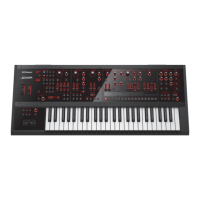54
Eects
About the STEP RESET Function
04: Step Filter
18: Slicer
The above types contain a sixteen-step sequencer. For these types,
you can use an MFX CONTROL to reset the sequence to play from
the rst step. To do this, set the MFX CONTROL Destination to “Step
Reset.”
For example, if you are using the modulation lever to control the
eect, you would make the following settings.
Parameter Value
Source CC01: Modulation
Destination Step Reset
Sens +63
With these settings, the sequence will play back from the rst step
whenever you operate the modulation lever.
Controlling an MFX via MIDI (MFX CONTROL)
You can use MIDI messages such as control change messages to
control the principal MFX parameters. This capability is called “MFX
CONTROL (multi-eects control).”
The parameters that can be controlled are preset for each MFX type,
and are the parameters marked by a “#” symbol in the explanations
of each MFX parameter on p. 25 and following. Up to four multi-
eects control settings can be assigned using MFX CONTROL.
To use MFX CONTROL, you’ll need to specify which MIDI message
(Source) will aect which parameter (Destination), and how greatly
(Sens).
Parameter Value Explanation
Source (1–4)
Species the MIDI message that will control the
corresponding MFX CONTROL parameter.
OFF MFX CONTROL will not be used.
CC01–31
Controller number
1–31
CC33–95
Controller number
33–95
BEND Pitch bend
AFT Aftertouch
SYS 1–4
Use the controller that is assigned
by the System Parameter setting Sys
Ctrl 1–4.
Destination
(1–4)
Refer to the
parameters
marked “#”
on p. 26 and
following
Selects the multi-eect parameter
that will be controlled by control
source 1–4. The type of parameters
that can be selected will depend
on the type of multi-eect you’ve
selected in MFX Type.
Sens (1–4) -63–+63
Species the depth of MFX
CONTROL.
Specify a positive (+) value if you
want to change the value of the
assigned destination in a positive
direction (larger, toward the right,
faster, etc.), or specify a negative
(-) value if you want to change
the value in a negative direction
(smaller, toward the left, slower, etc.).
Larger values will allow a greater
amount of control.

